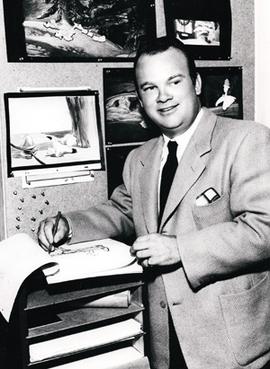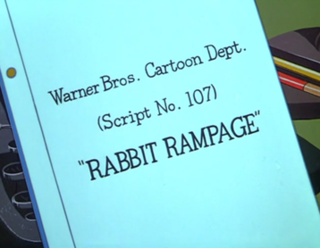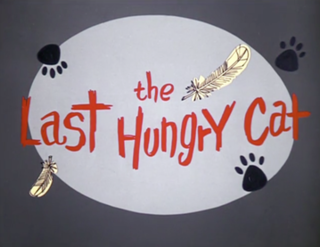
Frederick Bean "Tex" Avery was an American animator, cartoonist, director, and voice actor. He was known for directing and producing animated cartoons during the golden age of American animation. His most significant work was for the Warner Bros. and Metro-Goldwyn-Mayer studios, where he was crucial in the creation and evolution of famous animated characters such as Bugs Bunny, Daffy Duck, Porky Pig, Elmer Fudd, Droopy, Screwy Squirrel, The Wolf, Red Hot Riding Hood, and George and Junior.

The Big Bad Wolf is a fictional wolf appearing in several cautionary tales, including some of Grimms' Fairy Tales. Versions of this character have appeared in numerous works, and it has become a generic archetype of a menacing predatory antagonist.

Kaa is a fictional character from The Jungle Book stories written by Rudyard Kipling. He is a giant snake who is 30 feet long.
Jikininki appear in Lafcadio Hearn's Kwaidan: Stories and Studies of Strange Things (1904) as corpse-eating spirits. In Japanese Buddhism, jikininki, are similar to Gaki/Hungry ghost; the spirits of greedy, selfish or impious individuals who are cursed after death to seek out and eat humans and human corpses.
Cecil Turtle is a fictional character in the Warner Bros. Looney Tunes and Merrie Melodies series of films. Though he made only three theatrical appearances, Cecil has the unusual distinction in that he is one of the very few characters who was able to outsmart Bugs Bunny, and the only one to do so three times in a row and at the rabbit's own game.
"Hungry, Hungry Homer" is the fifteenth episode of the twelfth season of the American television series The Simpsons. It first aired on the Fox network in the United States on March 4, 2001. In the episode, Homer becomes a Good Samaritan after discovering the simple joys of helping people in need – which is put to the test when he goes on a hunger strike after the owner of the Springfield Isotopes baseball team attempts to discredit him when Homer stumbles on his plot to discreetly move the team to Albuquerque, New Mexico.

Little Red Riding Rabbit is a 1944 Warner Bros. Merrie Melodies cartoon, directed by Friz Freleng, and starring Bugs Bunny. It is a sendup of the Little Red Riding Hood story, and is the first time in which Mel Blanc receives a voice credit.

The Little Orphan is a 1949 American one-reel animated cartoon and the 40th Tom and Jerry cartoon, released in theaters on April 30, 1949 by Metro-Goldwyn Mayer. It was produced by Fred Quimby and directed by William Hanna and Joseph Barbera, with music by Scott Bradley. The cartoon was animated by Irven Spence, Kenneth Muse, Ed Barge and Ray Patterson. The short features Nibbles, a young mouse who is insatiably hungry.

The Adventures of Brer Rabbit is a 2006 American animated comedy film loosely inspired by the African American Br'er Rabbit stories popularized by Joel Chandler Harris. The film notably features an all-black cast, including Nick Cannon as the titular character. It was described by The Washington Post as having hip-hop influences. It was nominated for the Best Home Entertainment Production Annie Award.

"Rabbot" is the series premiere of the animated television series Aqua Teen Hunger Force. A rough-cut version of this episode originally aired in the United States prior to the launch of Adult Swim on December 30, 2000 on Cartoon Network unannounced, the final cut of this episode later aired on Adult Swim on September 16, 2001. In the episode Master Shake, Frylock, and Meatwad investigate the recent destruction of Carl's car, while a giant mechanical rabbit destroys downtown.

Rabbit Rampage is a 1955 Warner Bros. Looney Tunes animated cartoon, directed by Chuck Jones. The short was released on June 11, 1955, and stars Bugs Bunny.

Who Framed Roger Rabbit is a media franchise owned by The Walt Disney Company and Amblin Entertainment, that began with the 1988 film, Who Framed Roger Rabbit, itself based on a book titled Who Censored Roger Rabbit? by Gary K. Wolf.

The Iceman Ducketh is a 1964 Warner Bros. Looney Tunes theatrical cartoon directed by Phil Monroe and Maurice Noble, with a story by John W. Dunn. The short was released on May 16, 1964, and stars Bugs Bunny and Daffy Duck. It was the last Warner Bros. theatrical cartoon featuring Bugs and Daffy together until Box-Office Bunny in 1991, and the last that Chuck Jones worked on, though he was fired at an early stage of production and replaced by Monroe.

The Last Hungry Cat is a Warner Bros. Merrie Melodies cartoon animated short directed by Friz Freleng and Hawley Pratt. The short was released on December 2, 1961, and stars Tweety and Sylvester.

Bugs Bunny's 3rd Movie: 1001 Rabbit Tales is a 1982 animated anthology comedy film directed by Friz Freleng with a compilation of Warner Bros. cartoon shorts and animated bridging sequences with Bugs Bunny as the story host.

The Grasshopper and the Ants is a 1934 American animated short film produced by Walt Disney Productions and released by United Artists. Part of the Silly Symphonies series, the film is an adaptation of The Ant and the Grasshopper, one of Aesop's Fables. It was directed by Wilfred Jackson and stars Pinto Colvig as the voice of the grasshopper "Hop."

Goldimouse and the Three Cats is a 1960 Warner Bros. Looney Tunes animated cartoon directed by Friz Freleng. The short was released on March 15, 1960, and stars Sylvester and Sylvester Jr.
Billy Boy is a 1954 Southern Wolf animated short cartoon in the MGM cartoon theatrical series released by Metro-Goldwyn-Mayer, produced by Fred Quimby, and directed by Tex Avery. It is a spin-off of Avery's previous creation, Droopy, and stars his unnamed Southern-accented wolf, who previously appeared opposite Droopy in The Three Little Pups and in Blackboard Jumble and Sheep-Wrecked.
What's Buzzin' Buzzard? is a 1943 American animated short film directed by Tex Avery, produced by Fred Quimby, and musical score by Scott Bradley. The short pokes fun at the food shortages common at the time. The plot focuses on two turkey vultures struggling to find food in the desert. It was released to theaters on November 27, 1943 by Metro-Goldwyn-Mayer. Producer Fred Quimby disliked the cartoon but was surprised when it was put under the preservation in the Library of Congress. It is currently available on the Tex Avery Screwball Classics: Volume 1 Blu-Ray. The cartoon during production was under the title "Vulture A La King".

Roger Rabbit is an animated anthropomorphic rabbit. The character first appeared in author Gary K. Wolf's 1981 novel, Who Censored Roger Rabbit? In the book, Roger is second banana in a popular comic strip, "Baby Herman". Roger hires private detective Eddie Valiant to investigate why his employers, the DeGreasy Brothers, have reneged on their promise to give Roger his own strip. When Roger is found murdered in his home, Valiant sets out to look for the killer, with the help of Roger's "doppel".














